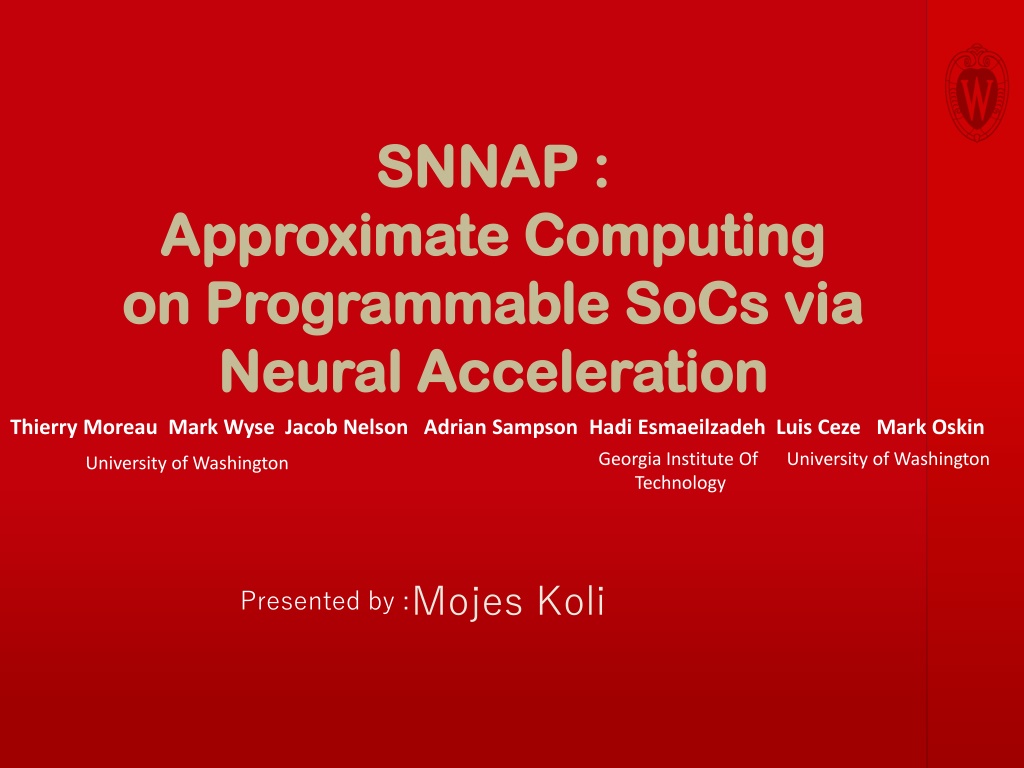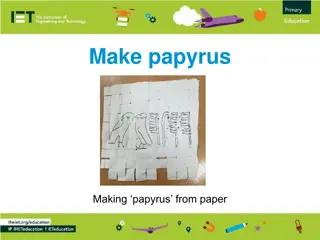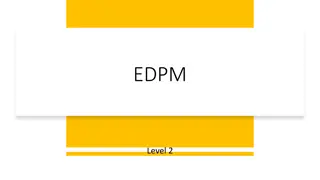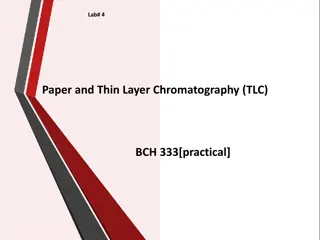
Neural Acceleration for Approximate Computing on Programmable SoCs
Explore how Neural Acceleration can enhance Approximate Computing on Programmable SoCs, improving efficiency by leveraging specialized logic and neural networks to perform tasks efficiently on silicon chips. This approach allows for trading accuracy for optimizations, paving the way for new avenues in computer architecture research.
Download Presentation

Please find below an Image/Link to download the presentation.
The content on the website is provided AS IS for your information and personal use only. It may not be sold, licensed, or shared on other websites without obtaining consent from the author. Download presentation by click this link. If you encounter any issues during the download, it is possible that the publisher has removed the file from their server.
E N D
Presentation Transcript
SNNAP : SNNAP : Approximate Computing Approximate Computing on Programmable on Programmable SoCs Neural Acceleration Neural Acceleration SoCs via via Thierry Moreau Mark Wyse Jacob Nelson Adrian Sampson Hadi Esmaeilzadeh Luis Ceze Mark Oskin Georgia Institute Of Technology University of Washington University of Washington Mojes Koli Presented by :
New Avenues in Computer Architecture New Avenues in Computer Architecture As the clock frequency of silicon chips is leveling off, the computer architecture community is looking for different solutions to continue application performance scaling. 1. Specialized logic in form of Accelerators Designed to perform special tasks efficiently compared to GPPs. Specialization leads to better efficiency by trading off flexibility for leaner logic and hardware resources 2. Exploiting Approximate Computing Today's computers are designed to compute precise results even when it is not necessary. Approximate computing trades off accuracy to enable novel optimizations http://www.purdue.edu/newsroom/releases/2013/Q4/approximate-computing-improves-efficiency,-saves- energy.html UNIVERSITY OF WISCONSIN-MADISON 2
Approximate Computing ? Approximate Computing ? 500 / 21 = ? Is it greater than 1 ? Is it greater than 30? Is it greater than 23? 3 Filtering based on precise calculations Filtering based on approx. calculations
Approximate Computing via Neural Acceleration Approximate Computing via Neural Acceleration 1. 2. 3. Identify Approximate code regions from source code. Train neural networks to mimic regions of approximate code. During Runtime , when CPU comes across this annotated code , offload this tasks, and sleep. 4. Such tasks now run on Neural Processing Unit (NPU) accelerators. Key points : -> NPU implemented in Programmable logic. -> During training , neural network s topology and weights are adjusted. -> Can target different applications without costly FPGA configurations. -> Low programmer effort. -> SNNAP : Neural Network Accelerator in Programmable logic UNIVERSITY OF WISCONSIN-MADISON 4
[22] Neural acceleration for general-purpose approximate programs 5
Architecture Design for SNNAP Architecture Design for SNNAP -> NPU & Processor operate independently -> Each PU has a control unit to orchestrate comm. between PEs and SIG. -> Neural networks are based in Multi-layer Perceptron SIG : Sigmoid Function unit PU : Processing units PE : Processing elements -> 3 communication Interface on Zynq PSoC. 1. Medium-throughput General Purpose IOs (GPIOs) During configuration. - Latency as low as 114 CPU cycle roundtrip . 2.High-throughput ARM Accelerator Coherency Port (ACP) During Execution. - Latency as low as 93 CPU cycle roundtrip . 3. Two unidirectional event lines eventi and evento During Synchronization. - Latency of 5 CPU cycles. 6
Multi Multi- -layer Perceptron (MLP) layer Perceptron (MLP) - > Artificial Neural Network (ANN) model. - > Maps sets of input data onto a set of appropriate outputs - > MLP utilizes a supervised learning technique called backpropagation for training the network - > The goal of any supervised learning algorithm is to find a function that best maps a set of inputs to its correct output. 7
Multi Multi- -layer Perceptron (MLP) layer Perceptron (MLP) General idea of supervised learning General idea of supervised learning 1. Send the MLP an input pattern, x, from the training set. 2. Get the output from the MLP, y. 3. Compare y with the right answer , or target t, to get the error quantity. 4. Use the error quantity to modify the weights, so next time y will be closer to t. 5. Repeat with another x from the training set. 8
Processing Unit Processing Unit Datapath Datapath - > Hardware implementation of MLPs. -> Weights are statistically partitioned on local block-RAM (BRAM) -> Accumulator FIFO stores partial sums when number of inputs > number of PEs. -> Sigmoid FIFO stores output until final evaluation is complete. Final result goes to CPU caches. -> PU can support arbitrary number of PEs. -> 16-bit signed fixed-point numeric representation with 7 fraction bits internally. -> 48 bit fixed-point adder to overcome overflow in long chain of complex tasks. 9
Sigmoid Unit Sigmoid Unit Datapath Datapath - > Applies Activation function to outputs from PE chain. - > Applies linear approximation or +/- 1 approximation based on input size. - > SNNAP uses 3 commonly used activation functions, namel sigmoid, hyperbolic and linear activation function. 10
Overview Overview 11
Evaluation Evaluation Applications used in evaluation Microarchitectural parameters for the Zynq platform, CPU, FPGA and NPU. 12
Performance and Energy benefits Performance and Energy benefits -> Inversek2j has the highest speedup - Trigonometric function calls , taking over 1000 cycles on CPU, but small NN runs faster. -> kmeans has the lowest speedup - Approximate code is small to run efficiently on CPU, but NN is deep. -> Average speedup is 3.78x. -> Zynq+DRAM - Power supplies for the Zynq chip and its associated DRAM, peripherals and FPGA -> Core logic only - No DRAM or peripherals included. -> Inversek2j shows highest gains -> jmeint and kmeans shows worst energy performance. 13
Impact of parallelism Impact of parallelism -> Higher PU counts lead to higher power consumption - However, the cost can be offset by the performance gain. -> The best energy efficiency occurs at 8 PUs for most benchmarks - exceptions are jpeg and fft. 14
Optimal PE count Optimal PE count 15
HLS Comparison Study HLS Comparison Study -> Used Vivado HLS to synthesize specialized hardware datapath for target regions which were tested in previous evaluations. -> Integrated in CPU-FPGA interface and compared it with SNNAP for speedup , resource-normalized throughput , FPGA unitization and programmer efforts. Speedup 16
HLS Comparison Study HLS Comparison Study Resource-normalized throughput -> Isolated FPGA execution from the rest of the application to carry out this calculations. 17
HLS Comparison Study HLS Comparison Study Programmer Efforts -> SNNAP : No hardware knowledge. -> HLS tools : significant programmer effort and hardware-design expertise is still often required 18
Shortcomings -> Latency between CPU and NPU is still high. -> Cannot scale to applications with high bandwidth requirements. -> Can use support vector machine model. Key Points. -> Designed to work with a compiler workflow that automatically configures the neural network s topology and weights instead of the programmable logic itself. -> Enables effective use of neural acceleration in commercially available devices. -> NPUs can accelerate a wide range of computations. -> SNNAP can target many different applications without costly FPGA reconfigurations. -> expertise required to use SNNAP can be substantially lower than designing custom FPGA configurations.. 19
Impact of batching Impact of batching -> Non-batched communication leads to slowdown - Since affect of communication latency can be seen here. -> Batch invocations hide such latencies by amortizing them. 22
FPGA Utilization FPGA Utilization 23
Approximate Computing : Applications Approximate Computing : Applications -> One example is video rendering, where the eye and brain fill in any missing pixels. -> Other applications where a certain percentage of error can be tolerated without affecting the quality of the result as far as the enduser is concerned include: -> wearable electronics -> voice recognition -> scene reconstruction -> Web search -> Fraud detection -> financial and data analysis -> process monitoring -> robotics -> tracking tags and GPS -> audio, image, and video processing and compression (as in Xbox and PS3 videogaming). 24






















